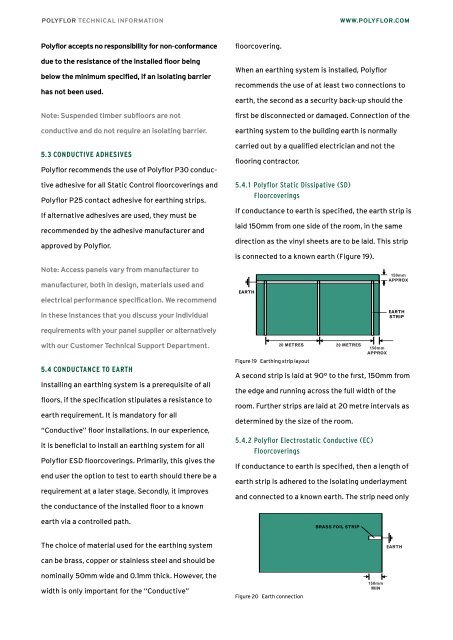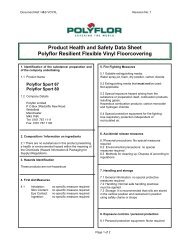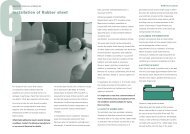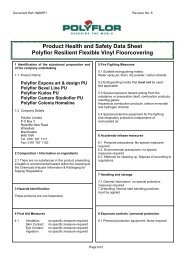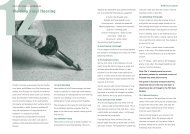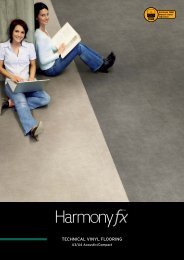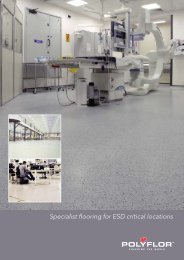floorcoverings - Polyflor
floorcoverings - Polyflor
floorcoverings - Polyflor
You also want an ePaper? Increase the reach of your titles
YUMPU automatically turns print PDFs into web optimized ePapers that Google loves.
POLYFLOR TECHNICAL INFORMATION<br />
WWW.POLYFLOR.COM<br />
<strong>Polyflor</strong> accepts no responsibility for non-conformance<br />
due to the resistance of the installed floor being<br />
below the minimum specified, if an isolating barrier<br />
has not been used.<br />
Note: Suspended timber subfloors are not<br />
conductive and do not require an isolating barrier.<br />
5.3 CONDUCTIVE ADHESIVES<br />
<strong>Polyflor</strong> recommends the use of <strong>Polyflor</strong> P30 conductive<br />
adhesive for all Static Control <strong>floorcoverings</strong> and<br />
<strong>Polyflor</strong> P25 contact adhesive for earthing strips.<br />
If alternative adhesives are used, they must be<br />
recommended by the adhesive manufacturer and<br />
approved by <strong>Polyflor</strong>.<br />
Note: Access panels vary from manufacturer to<br />
manufacturer, both in design, materials used and<br />
electrical performance specification. We recommend<br />
in these instances that you discuss your individual<br />
floorcovering.<br />
When an earthing system is installed, <strong>Polyflor</strong><br />
recommends the use of at least two connections to<br />
earth, the second as a security back-up should the<br />
first be disconnected or damaged. Connection of the<br />
earthing system to the building earth is normally<br />
carried out by a qualified electrician and not the<br />
flooring contractor.<br />
5.4.1 <strong>Polyflor</strong> Static Dissipative (SD)<br />
Floorcoverings<br />
If conductance to earth is specifıed, the earth strip is<br />
laid 150mm from one side of the room, in the same<br />
direction as the vinyl sheets are to be laid. This strip<br />
is connected to a known earth (Figure 19).<br />
EARTH<br />
150mm<br />
APPROX<br />
EARTH<br />
STRIP<br />
requirements with your panel supplier or alternatively<br />
with our Customer Technical Support Department.<br />
5.4 CONDUCTANCE TO EARTH<br />
Installing an earthing system is a prerequisite of all<br />
floors, if the specifıcation stipulates a resistance to<br />
earth requirement. It is mandatory for all<br />
“Conductive” floor installations. In our experience,<br />
it is beneficial to install an earthing system for all<br />
<strong>Polyflor</strong> ESD <strong>floorcoverings</strong>. Primarily, this gives the<br />
end user the option to test to earth should there be a<br />
requirement at a later stage. Secondly, it improves<br />
the conductance of the installed floor to a known<br />
earth via a controlled path.<br />
Figure 19 Earthing strip layout<br />
20 METRES 20 METRES<br />
A second strip is laid at 90º to the fırst, 150mm from<br />
the edge and running across the full width of the<br />
room. Further strips are laid at 20 metre intervals as<br />
determined by the size of the room.<br />
5.4.2 <strong>Polyflor</strong> Electrostatic Conductive (EC)<br />
Floorcoverings<br />
150mm<br />
APPROX<br />
If conductance to earth is specifıed, then a length of<br />
earth strip is adhered to the isolating underlayment<br />
and connected to a known earth. The strip need only<br />
BRASS FOIL STRIP<br />
The choice of material used for the earthing system<br />
EARTH<br />
can be brass, copper or stainless steel and should be<br />
nominally 50mm wide and 0.1mm thick. However, the<br />
width is only important for the “Conductive”<br />
Figure 20 Earth connection<br />
150mm<br />
MIN


